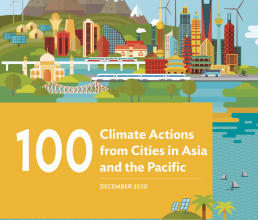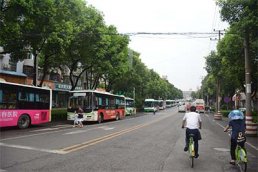First appeared in

Asian Development Bank
100 Climate Actions from Cities in Asia and the Pacific
Xiangtan plans to contribute to a modal shift from private to low-carbon, public alternatives through improvements to pedestrian pathways and bicycle lanes city-wide, demonstrating the different functions of the road.
Xiangtan plans to contribute to a modal shift from private to low-carbon, public alternatives through improvements to pedestrian pathways and bicycle lanes city-wide, demonstrating the different functions of the road.
Three initiatives are being implemented in Xiangtan that will help boost public transportation in the city, decrease congestion, and reduce emissions by improving pedestrian, cycling, and public transportation infrastructure. The incorporation of ecosystem-based adaptation measures will improve drought, flood resilience, and air quality while also transforming the street into a pleasant space for relaxing and resting.
263K
TONS OF CO₂ EQUIVALENT REDUCED EVERY YEAR
TONS OF CO₂ EQUIVALENT REDUCED EVERY YEAR
The first two projects focus on walking and cycling in the city center, with improvements to 63 kilometers (km) of cycle lanes and 69 km of pedestrian walkways. These routes will be safely separated from roads and seamlessly connected at intersections and crossings. The pedestrian walkways will have no barriers, be free of parked vehicles, and contain smooth ramps to make walking easy for all.
The third initiative focuses on transforming the six-lane Fuxing Middle Road, which is located in a flood-prone zone. Various initiatives such as a bus-priority lane, improved pedestrian pathways and bicycle lanes, will seek to transform Fuxing Middle Road into a multi-functional street. The reconstruction of a large landscaping area into a street forest will encourage walking and relaxing, and the inclusion of water pervious street parking spaces will reduce runoff. Ecosystem-based adaptation measures like tree planting, rain gardens, and subsurface water retention boxes, will also aim to boost livability in the city.
An ADB loan has been provided to help cover the $32 million cost for all three projects.

In many areas, pedestrian and cycling lanes are not clearly marked and vehicles park on the street. Together with ecosystem-based adaptation measures, improvements will make Xiangtan’s streets multi-functional and resilient (photo by Royal HaskoningDHV).
The Challenge
Xiangtan is currently more suited to transport by car or motorbike, and roads often prioritize private vehicles.
Co-Benefits
Environment Ecosystem-based adaptation measures will reduce pollution in downstream areas by filtering pollutants and improving runoff quality.
Social New pedestrian pathways will accommodate wheelchair users by making sure they are wide and free from obstacles, improving accessibility for all.
Health With better air quality, non-motorized transport options, and safer roads, residents will be more active and decrease their risk of certain diseases.

